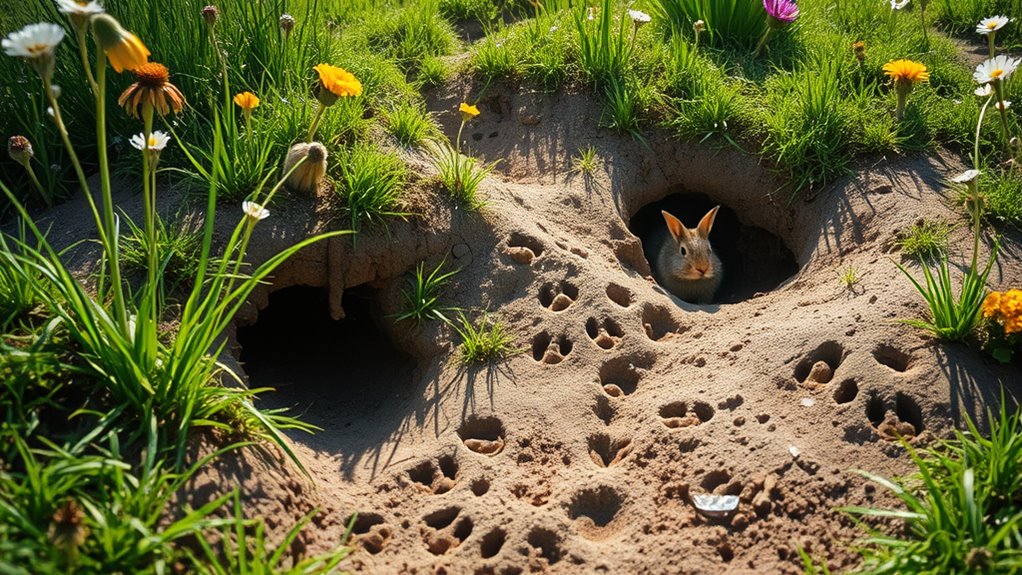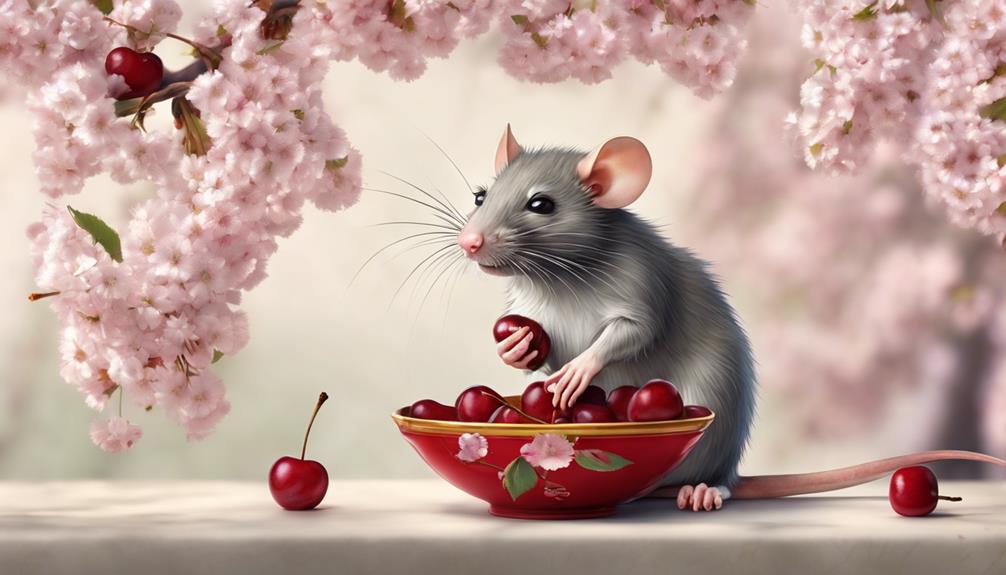Animal burrows are essential for ecosystems, providing shelter and safe havens for various species, while also enhancing soil health. They aerate the ground, allowing for better water infiltration and nutrient cycling, which benefits plant growth. Burrows create microhabitats that support biodiversity and foster interactions among wildlife. These structures play a significant role in maintaining the balance of local ecosystems. Discover how burrowing animals influence their environments and the challenges they face today.
Key Takeaways
- Burrows provide crucial habitats and shelter for various species, enhancing survival rates and biodiversity within ecosystems.
- They serve as nutrient cycling hubs, aerating soil and promoting plant growth through improved water infiltration and root access.
- Burrowing species, like prairie dogs, act as ecosystem engineers, modifying environments and supporting diverse wildlife interactions.
- Burrows help maintain soil health and structure, preventing erosion and supporting a variety of plant communities.
- Effective management of burrowing animals is essential for balancing ecological benefits with economic impacts on agriculture and landscaping.
The Structure and Function of Burrows
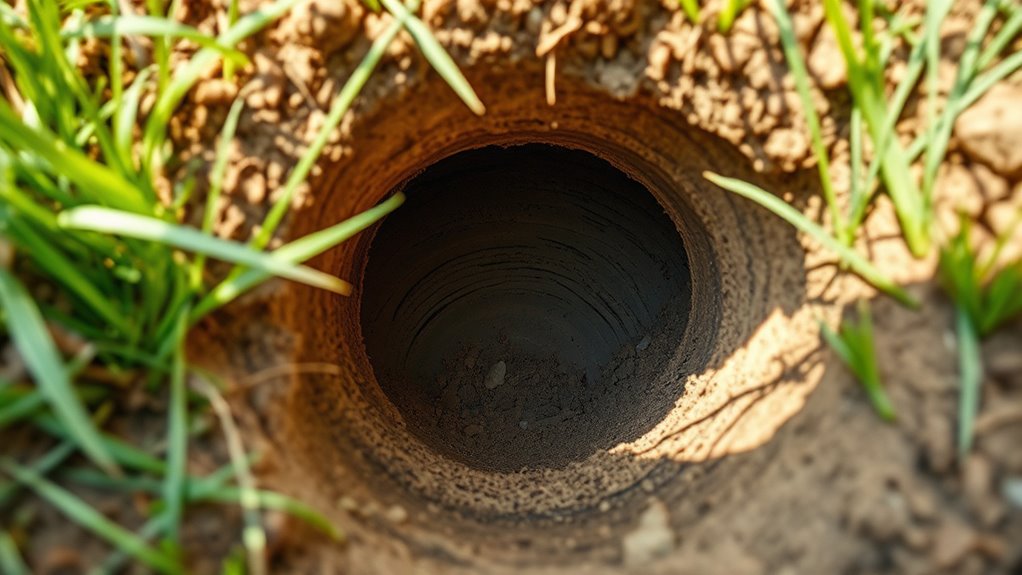
When you think about animal burrows, you might picture simple tunnels, but these structures can actually vary greatly in complexity. Some burrows serve as intricate networks filled with multiple chambers, where animals keep their young safe and even give birth.
These spaces provide ample room for habitation and nurturing, sometimes even being larger than the burrowing animal itself. Additionally, certain burrows, like those of prairie dogs, function as granaries, storing up to 120 liters of food.
The structure not only offers shelter from predators but also creates microhabitats that support diverse ecosystems. Prairie dog towns can span over 64,000 square kilometers, showcasing how burrows greatly influence local vegetation and wildlife interactions.
Common Burrowing Species
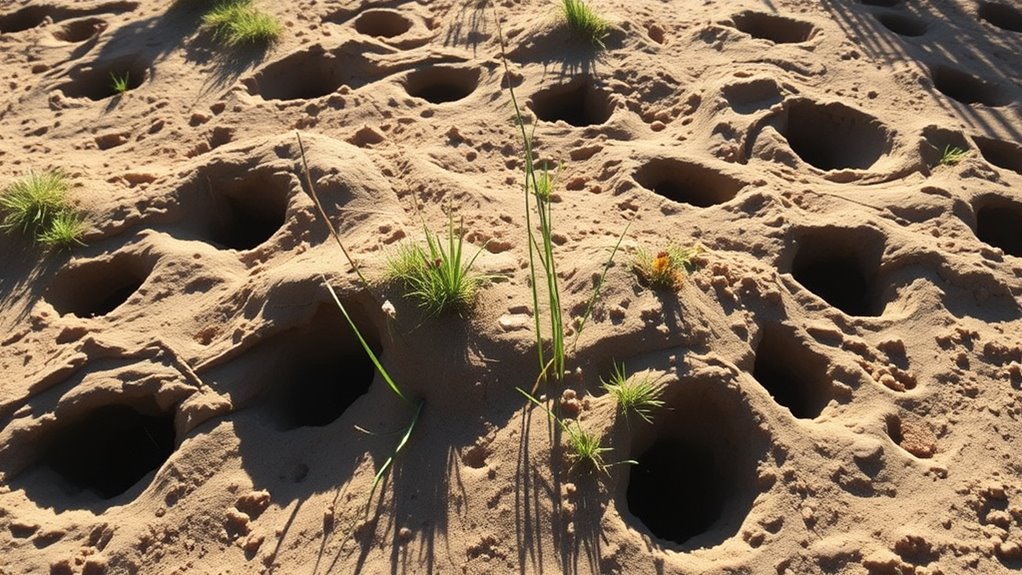
When you explore common burrowing species, you'll find gophers, prairie dogs, and groundhogs, each with unique behaviors and habitats.
Gophers craft elaborate tunnels and store food in impressive quantities, while prairie dogs live in vast, social colonies.
Groundhogs, on the other hand, are known for their disruptive burrowing habits, often making them a challenge for gardeners and farmers.
Gophers and Their Habitats
Though often seen as pests, gophers are fascinating small burrowing rodents that create intricate tunnel systems beneath the surface.
These burrows can be quite complex, featuring multiple chambers and entrances that provide shelter from predators. As they dig, gophers aerate the soil, enhancing plant growth by improving water infiltration and nutrient distribution.
Their burrows also serve as granaries, storing up to 120 liters of food to sustain them during lean times.
Plus, when gophers abandon their burrows, other species can repurpose these shelters for their own use. This interplay not only showcases the gophers' role in their ecosystem but also highlights the importance of their unique habitats in supporting diverse wildlife.
Prairie Dogs' Social Structure
Prairie dogs exemplify a fascinating social structure that goes beyond mere survival, as they form complex towns that can host thousands of individuals. These towns cover vast areas, promoting cooperation and interaction among members.
Here are some key aspects of their social structure:
- Organized into family groups called coteries, consisting of a dominant male, several females, and their young.
- Highly developed communication skills with various vocalizations to alert others about predators.
- Living in large groups deters predators and boosts successful foraging.
- Their interactions enhance local ecosystems, fostering the growth of nutrient-rich forbs.
- Towns can span over 64,000 square kilometers, showcasing their extensive habitat.
Understanding these dynamics highlights the prairie dog's role in their environment and community.
Groundhogs' Burrowing Behavior
While prairie dogs showcase intricate social structures, groundhogs, or woodchucks, exhibit their own unique burrowing behavior.
These animals dig extensive burrow systems that can reach up to 30 feet long, featuring multiple chambers for nesting, sleeping, and food storage. Their burrows give them shelter from predators like coyotes and bobcats, boosting their survival odds.
Groundhogs create granaries inside their burrows, storing roots and grasses to help them through winter hibernation. However, their burrowing can lead to soil erosion and damage to gardens and crop fields.
Additionally, these structures are essential for birthing and nurturing young, making groundhogs' burrows critical for their reproductive success. Understanding their behavior sheds light on their role in the ecosystem.
The Role of Burrows in Ecosystems
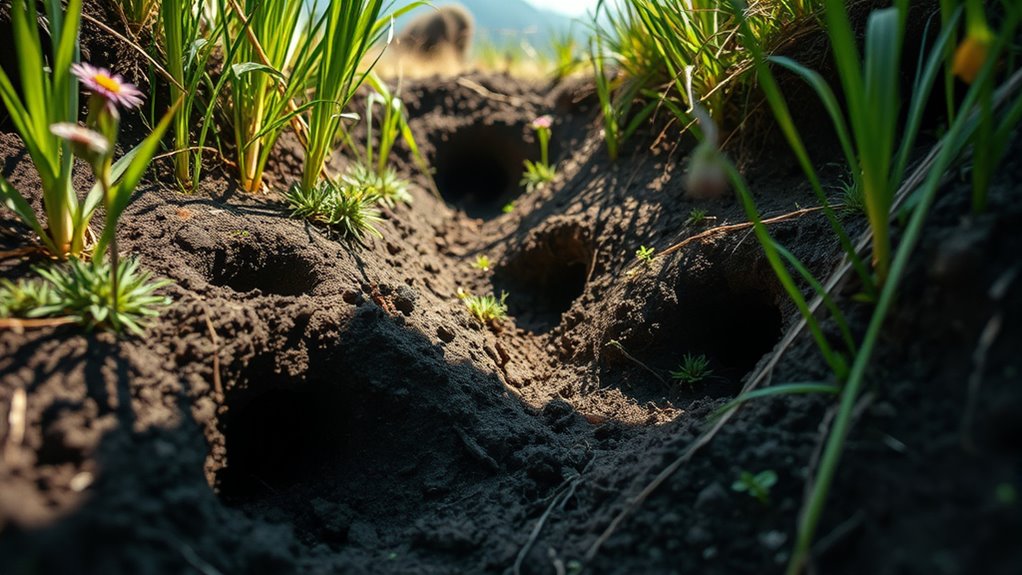
Burrows play an essential role in ecosystems, as they offer shelter and breeding grounds for a variety of species.
When you consider their impact, you'll find that:
- Burrows provide safe living spaces and nurseries for animals like prairie dogs and groundhogs.
- They create complex networks that aerate soil and cycle nutrients, promoting diverse plant growth.
- Burrowing animals boost ecosystem health by fostering microhabitats that support other wildlife.
- Their excavation can influence the landscape, causing soil erosion and altering water drainage.
- Prairie dog towns, spanning over 64,000 square kilometers, illustrate the extensive ecological impact of burrows on local ranching and biodiversity.
Recognizing these roles helps you appreciate the interconnectedness of life within ecosystems shaped by burrowing animals.
Burrows as Safe Havens for Young Animals
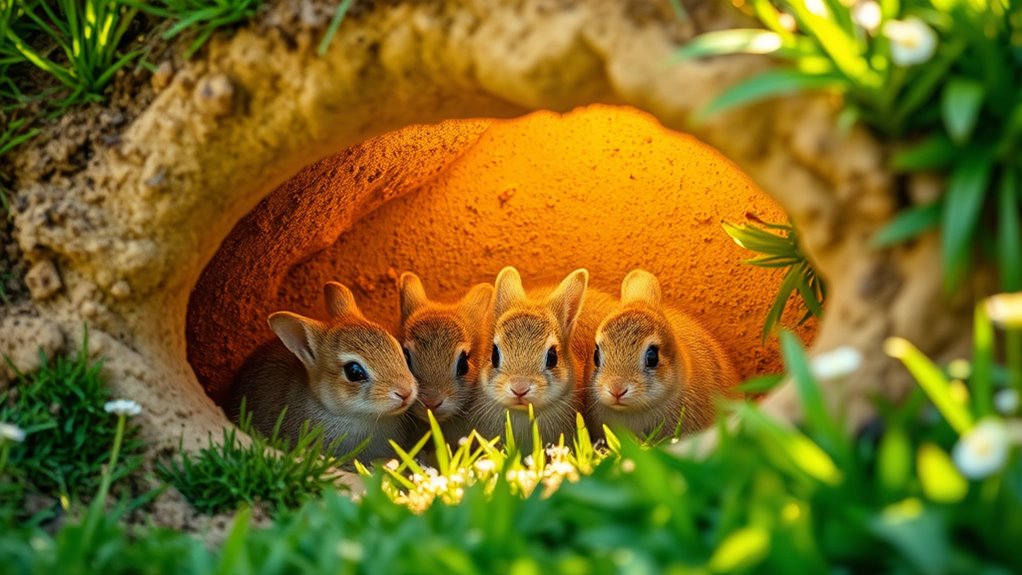
When you think about young animals, burrows play an essential role as safe havens.
These underground shelters not only provide secure birthing locations but also protect the little ones from predators.
Safe Birthing Locations
In nature, finding a safe haven for birthing can be a matter of life and death for young animals. Burrows serve as ideal locations, offering protection and support during this vulnerable time.
Here's why burrows are vital for young animals:
- Secure environments shield offspring from predators.
- Intricate burrow systems include separate chambers dedicated to birthing.
- The structure helps regulate temperature, essential for young development.
- Communal burrows in prairie dog colonies provide social support.
- Utilizing burrows reduces predation risk, boosting survival rates.
Predator Protection Strategies
While young animals face numerous dangers from predators, the intricate networks of burrows provide essential protection.
These burrows serve as safe havens, shielding vulnerable creatures from threats like coyotes and bobcats, ultimately boosting their survival rates.
Prairie dogs, for instance, create complex structures that house entire colonies, allowing for communal defense.
Warthogs utilize burrow networks to safeguard their young, with the mother's presence acting as a powerful deterrent against intruders.
Many burrowing animals, like groundhogs and gophers, strategically dig their homes in dense vegetation, minimizing exposure to predators.
The social dynamics within prairie dog towns further enhance safety, as increased vigilance and collective defense mechanisms keep young animals secure from lurking dangers.
Nurturing Young Development
Animal burrows not only offer protection from predators but also serve as nurturing environments for young animals.
These underground havens are essential for the early stages of life, providing safety and care. Here's how they help:
- Secure environments shield young from threats like coyotes and bobcats.
- Many burrowing species, like groundhogs and prairie dogs, use burrows as nurseries.
- Specialized chambers in burrows are designed for birthing and raising young.
- Prairie dog towns foster communal care, enhancing the survival of offspring.
- Warthogs' burrow networks deter predators, with mothers ready to defend their young.
Impact of Burrowing Animals on Soil Health

Burrowing animals play an essential role in enhancing soil health through their natural tunneling activities. When they dig, they aerate the soil, improving its structure and promoting water infiltration.
This aeration reduces soil compaction, allowing roots to grow better and take up nutrients more effectively. With increased burrow presence, you'll also notice a boost in microbial diversity and activity, which fosters healthier ecosystems.
Additionally, as these animals deposit organic matter and nutrients from waste and decaying plants, the surrounding soil becomes enriched. For example, prairie dogs not only create burrows but also promote the growth of nutrient-rich forbs, ultimately improving soil fertility and supporting diverse plant communities.
Burrowing animals enrich soil with organic matter, enhancing fertility and supporting diverse plant communities.
Your garden or local landscape benefits immensely from these crucial contributions.
The Interconnectedness of Burrows and Plant Growth
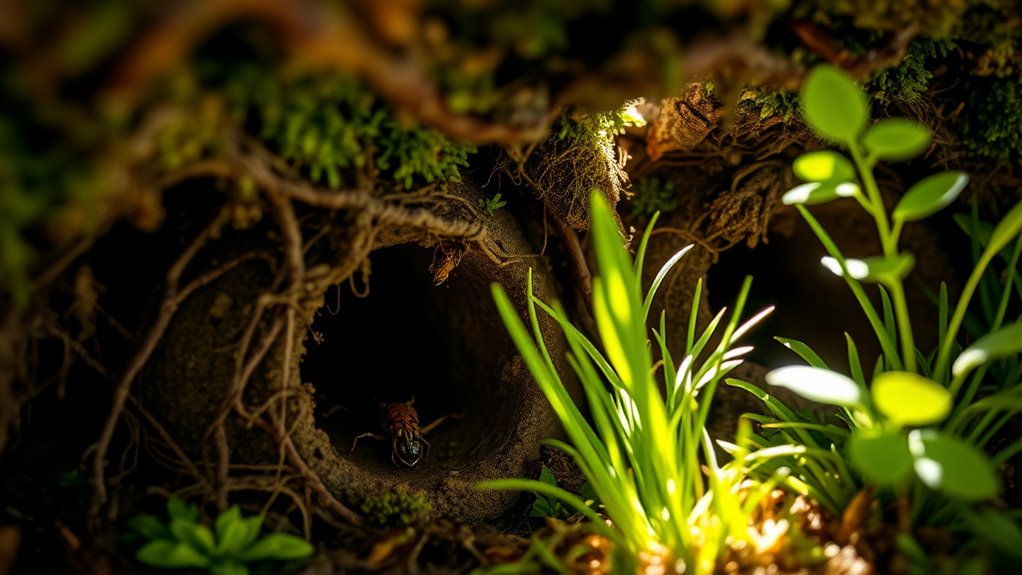
When you think about burrowing animals, consider how their tunnels boost plant growth.
By aerating the soil and cycling nutrients, these creatures create an environment where plants can thrive.
This interconnectedness not only enhances individual plant health but also supports the overall biodiversity of the ecosystem.
Nutrient Cycling Benefits
While you mightn't think of animal burrows as significant contributors to plant growth, they play an important role in nutrient cycling within ecosystems.
Here's how these burrows benefit plant life:
- Burrows created by animals like prairie dogs promote nutrient-rich forbs, enhancing soil health.
- The digging activities aerate the soil, improving water infiltration and root penetration.
- As animals forage, they expose seeds and materials, facilitating germination and increasing plant diversity.
- Nutrients from decaying organic matter in burrows enrich surrounding soil, creating fertility.
- Complex burrow systems retain moisture, supporting plant life during dry periods.
These interconnected processes show just how crucial animal burrows are to maintaining a thriving ecosystem and promoting healthy plant growth.
Soil Aeration Effects
Animal burrows greatly enhance soil aeration, which directly influences plant growth and health. When animals like prairie dogs and gophers dig, they create tunnels that improve water penetration and root expansion, leading to healthier plants.
Their burrowing activity increases soil porosity, enhancing drainage and reducing waterlogging risks. Moreover, by mixing decaying plant matter and organic waste into the soil, these animals enrich nutrient availability for plants.
You'll also notice that areas with active burrowing animals boast a higher diversity of plant species, as their burrows form microhabitats ideal for various plants.
In addition, the burrows stabilize soil structure, helping to mitigate erosion and supporting better plant growth while preserving crucial topsoil.
Burrows and Biodiversity Enhancement
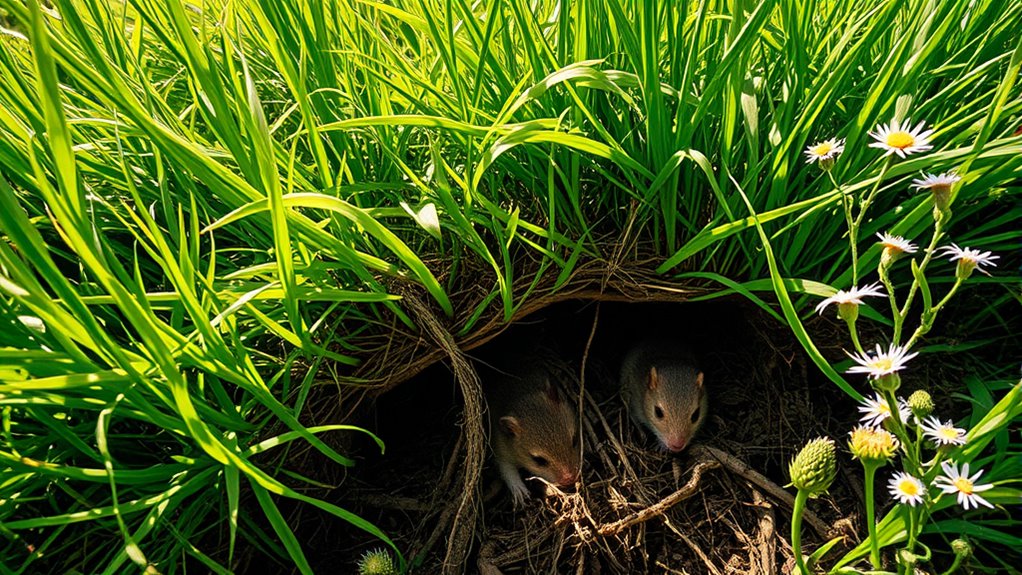
Burrows created by animals like prairie dogs greatly enhance biodiversity, as they promote the growth of nutrient-rich forbs that serve as essential food sources for various herbivores.
Burrows from prairie dogs boost biodiversity by fostering nutrient-rich forbs vital for herbivores.
These burrows also support a diverse ecosystem in several ways:
- Provide habitats for insects and small mammals, increasing species richness.
- Create unique microhabitats in prairie dog towns that span over 64,000 square kilometers.
- Maintain soil health and structure, preventing erosion and promoting water retention.
- Act as ecosystem engineers, modifying environments to create opportunities for other species.
- Foster a dynamic ecological community, allowing multiple species to coexist.
Human Interactions With Burrowing Animals

Interactions between humans and burrowing animals can often lead to conflict, particularly when gopher towns invade gardens and landscaping. You might find that these disruptions result in economic losses, frustrating homeowners and farmers alike.
Groundhog burrows can also wreak havoc on agricultural machinery, creating additional headaches for those managing fields. Historically, ranchers have tried to eradicate prairie dog populations using poisons and hunting methods, but many are now discovering ways to coexist that require fewer resources.
Prairie dog towns, which can span over 64,000 square kilometers, often exist in conservation areas, emphasizing the need to balance human activities with ecosystem preservation. Finding effective management strategies is essential to minimize the impact of these burrowing species on our lives.
Economic Impacts of Burrowing Species
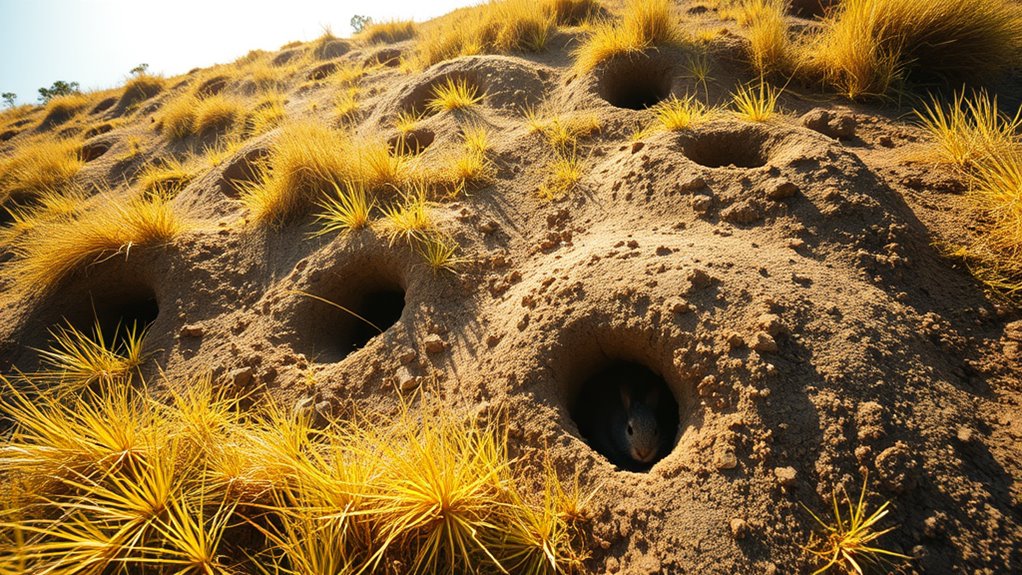
While you might appreciate the ecological role of burrowing species, their economic impacts can be quite significant.
Consider the following:
- Burrowing animals like gophers and groundhogs can damage gardens and landscaping, increasing costs for farmers and landowners.
- Termite infestations cost around $1.5 billion annually in the southwestern U.S. due to their destruction of wooden structures.
- Prairie dog towns, covering over 64,000 square kilometers, can disrupt livestock grazing patterns.
- The presence of burrowing animals may lead to soil erosion and flooding, complicating land management.
- Conversely, they can promote the growth of nutrient-rich forbs, potentially enhancing livestock productivity, benefiting ranchers economically.
Understanding these impacts helps you appreciate the balance between ecological roles and economic challenges.
Conservation Efforts for Burrowing Animals

The economic challenges posed by burrowing species highlight the need for effective conservation efforts. Protecting habitats in national parks and conservation areas is essential since these are where most prairie dog populations thrive.
Implementing management strategies fosters coexistence between ranchers and prairie dogs, showing that their presence can actually boost the growth of nutrient-rich forbs, benefiting livestock as well.
Burrowing animals are important for ecosystem health, with prairie dog towns enhancing biodiversity through soil aeration and nutrient cycling. Preserving their burrow systems is critical, as these shelters support various species and maintain ecological balance by providing refuge from predators.
Ongoing research is key to understanding their roles and shaping policies to combat habitat loss and agricultural pressures. By promoting mindful consumption, we can ensure that the ecological contributions of burrowing animals are recognized and preserved for future generations.
Frequently Asked Questions
Why Are Burrowing Animals Important?
Burrowing animals are essential for maintaining healthy ecosystems. When they dig, they aerate the soil, which improves water infiltration and promotes plant growth.
Their burrows also provide shelter for various species, enhancing biodiversity. You mightn't realize it, but those tunnels help cycle nutrients by mixing organic material into the ground.
Plus, they store food in burrows, important for survival during tough times. Their presence supports a balanced and thriving environment.
Why Are Burrows Effective?
Burrows are effective because they create a safe haven for animals, protecting them from predators and harsh weather.
You'll find that these underground structures maintain a stable environment, making it easier for animals to raise their young and store food.
Additionally, burrows aerate the soil, improving its fertility, which can enhance plant growth.
This natural process also helps stabilize the ground, reducing soil erosion and promoting a healthier ecosystem overall.
What Are the Ecological Roles of Burrowing Animals?
Isn't it ironic how small burrowing animals can have such a big impact? When you think about it, they play vital ecological roles.
Their tunnels aerate the soil, allowing water to penetrate better, and their foraging stimulates plant growth. By creating habitats for other species, they foster biodiversity.
Plus, their burrowing activities enhance nutrient cycling, making the ecosystem healthier.
What Is Burrows Used For?
Burrows are used for various purposes, primarily as safe living spaces for animals.
You'll find they provide shelter from predators and harsh weather, making them vital for survival. Some burrows even store food, acting as granaries for animals like rodents.
Additionally, they can create complex networks that enhance social structures among species.
Ultimately, burrows serve as significant habitats, contributing to individual safety and community dynamics in the animal kingdom.
Conclusion
In understanding the importance of animal burrows, you see their role in enhancing ecosystems, enriching soil health, and supporting biodiversity. You recognize that burrows provide safe havens for young animals, fostering survival and growth. You appreciate the economic impacts of these burrowing species, from agriculture to tourism. As you consider the conservation efforts needed, you realize that protecting burrowing animals not only safeguards their habitats but also sustains the intricate web of life they support.
